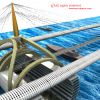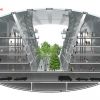Mor Temor
Arch. Mor Temor is international Architecture firm committed to designing unique buildings and one of a kind architectural concepts.

Floating bridge over the Strait of Messina:
why?
Unique concept.
The Strait of Messina, its beautiful nature and its rich and long history, deserves a bridge of great architectural value. Deserves a work of art unique in its kind, like the Tower of Pisa and the Ponte Vecchio in Florence, the Piazza di San Marco in Venice, etc.
.


So far, I think, no one has thought to give the Bridge in the Strait its true value. All the designers have only thought of a traditional bridge, to pass the passengers from side to side.
The "state of the art" bridge (3,3 km span) which was considered by the designers the best of all the proposals, has never been realized until now. Many researchers have examined the subject and tried to give answers.
I want to mention here some of them.
The authors of "Geological and stability aspects for the Messina Strait Bridge", Alessandro Guerricchio and Maurice Ponte (University of Reggio Calabria, 2006), have concluded their research with the statement: "The slope stability analysis carried out for the gelogical section traced according to the Bridge axis in non-seismic conditions furnishes a safety factor value a little greater than 1, which means that the slope is very close to a critical condition. The same analysis, carried out refferring to a pseudostatic condition furnishes a safety factor less than 1. Due to the depth of the slip surfaces (some of which exceed 250 meters) it is very difficult to plan slope stabilization works to allow the building of the tower.".
The author of the article "Erroneous Mistakes and Solutions in Urban Planning: The Project for a Bridge over the Straits of Messina", Guido Signorino (University of Messina, 2004) wrote: "In this section, I will briefly synthesize some of the many reasons why the project appears completely uneconomical, both in a local and in a national perspective. At a local level, the bridge reduces social welfare because of environmental and congestion costs. Environmental costs of the bridge relate to its impact on the urban ecosphere: a) the natural reserve of Ganzirri (a European Communitary Interest Site) will be irreparably damaged; b) five or six sites to store more than 5 million m3 of residuals from the excavation works are localized in very dangerous positions, on the slopes of the Peloritani mountains, adjacent to residential parts of the town. In addition the bridge will be built 15 kms from the city centre, a total of 25.7 kms of railway and roadway tunnels and viaducts will connect the bridge with the most central areas of the town. The conclusion of the economic analysis of the project is definitely negative, because of: a) mistakes in traffic forecasts; b) under-estimation of investment costs; c) inaccuracies in cost-benefit analysis; d) negative consequences for the public balance and the Sicilian economy."
From the above mentioned, it is clear that the italian government should strive to find much more convenient alternative, economically and financially sustainable, in the same time socially more desirable.
I, perhaps, have one.
Floating Inhabited Bridge.
Ordinary bridges and tunnels (underground and submerged) were studied and evaluated to solve the problem of the Straits of Messina from various researchers. No doubt it was concluded that these structures are not able to make feasible the italian dream.
To realize the bridge is necessary to think differently. A Floating Inhabited Bridge. This is a unique concept of its kind, came to the world thanks to three years of laborious research done by me on floating structures.


The main characteristics of the Floating Inhabited Bridge proposed by me as an alternative to solve the problem of the Strait are as follows:
a) It uses water as foundation for the bridge decks and pylon. The proposed configuration rests on huge concrete Floating Inhabited units foundations that would be used as a support of commerce, hotels, work spaces, parking, parks, ecc. generating more than 3,000,000 m² of built space assets within the two arches-steel Living Decks that would be used also as a support of built habitable volumes of dwelling. A Floating foundations unit is chosen because of water depth more than 100 m and bedrock lies more than 250-m below the seabed, which makes conventional piled structure extremely expensive. Another reason for choosing floating foundations units is the seismic hazards dictated by proximity to the Etna volcanoes.
b) It can be constructed in a shipyard and floated (the Floating Platforms) comprising spans and pylon to the designated water crossing, erected and finished on site. So, saving costs and construction time.
c) The Floating Bridge will be financed by the sale of inhabited units, over 3,000,000 square meters of living space.
d) The economic benefit of constructing the Messina Strait Bridge will be felt nation wide as a result of better crossing facilities between Regio di Calabria and Messina cities, facilitating rapid regional development on both sides of the Strait, particularly in the tourism, industrial and natural resources development sectors. During construction local economic boom will emerge, as the various activities supporting the bridge construction will mobilize a huge amount of fund and forces benefiting the welfare of the region.
e) Thanks to the proposed Floating Bridge, the location of the bridge across the Strait of Messina no more depends on the minimum distance between Sicily and Calabria in order to assure that tower foundations are built on dry-lands. The total of 25.7 kms of railway and roadway tunnels and viaducts that was suggested to connect the bridge with the most central areas of the Sicily town will not be necessary.
f) Electric energy production using the currents of the Strait. The turbines would be installed on the seven floating elements, on the submerged parts, at 20 to 30 meters depth.
Photovoltaic colored solutions can also be integrated perfectly into the Floating Bridge, provide greater both acoustic and thermal insulation and at the same time produce clean, free energy in situ, all thanks to the power of the sun.
g) Environmental impact of the Floating Inhabited Bridge is far less than by other methods.
The project was sent to the Italian Ministry of Infrastructures on 15 November 2009.
In 13 November 2012 Arch. Mor Temor met in Rome the technical engineers of the Messina Strait Company (by the Italian Government), Ing. Joseph Fiammenghi, technical director of the Company, and Ing. Sparatore. During the meeting Temor delivered the project design to Messina Company.
Arch Mor Temor










